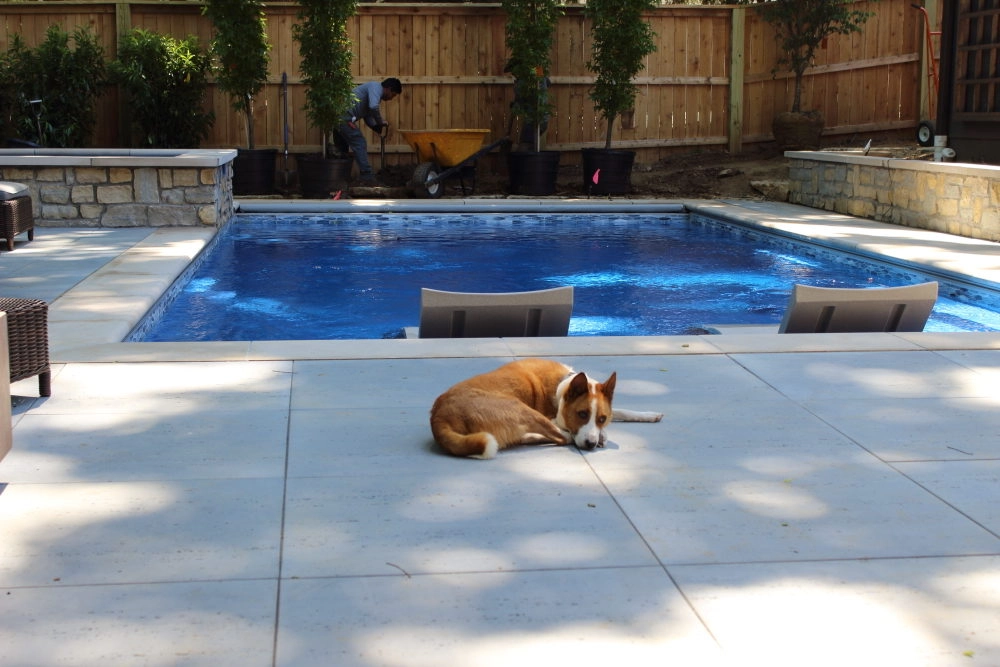
Can My Dog Swim in My Fiberglass Pool?
Canine Companions and Crystal Waters – Do They Mix?
Ever asked yourself “Can My Dog Swim in My Fiberglass Pool?” A brilliant bonding moment—or a potential recipe for disaster?
According to the American Pet Products Association, nearly 70% of U.S. households own a pet, and for many families, those pets are more than companions—they’re part of every summer memory. Picture this: a warm, golden afternoon, the sun sparkling off the water, and your dog paddling beside you in pure joy. It’s a scene straight from a backyard paradise.
Still, many pet owners hesitate. A common misconception is that dogs in swimming pools, especially those with delicate surfaces, could cause irreversible damage. But is that really true for fiberglass pools?
Letting your dog into your fiberglass pool is like welcoming them into your living room—inviting, comfortable, and safe, as long as you’ve set the ground rules. In this post, we’ll explore whether dogs and fiberglass pools are a safe match, how to maintain your pool with a four-legged swimmer in the mix, and how to make the most of your pool time together.
If you’ve ever asked yourself whether dogs in pool environments are safe—especially fiberglass ones—you’re not alone. Let’s dive in.
Is It Safe for Dogs? Understanding Fiberglass Pool Compatibility
Why Fiberglass Pools Are Dog-Friendly
Fiberglass pools are one of the most pet-compatible options on the market—and for good reason:
- Smooth Surface: Fiberglass has a gel-coat finish that’s gentle on paw pads, reducing the risk of scrapes or abrasions.
- Claw-Resistant: Unlike vinyl liners, fiberglass doesn’t tear or puncture from dog nails.
- Healthier Water: The non-porous surface of fiberglass resists algae and bacteria buildup, which helps maintain water quality and keeps your dog healthier.
These built-in advantages make fiberglass pools a smart and safe choice for pet-loving households.
Comparison with Other Pool Types
It’s important to understand how fiberglass stacks up against other materials when it comes to dog-friendliness:
- Concrete Pools: While durable, concrete surfaces are rough and can wear down your dog’s paw pads over time.
- Vinyl Liner Pools: These are softer but vulnerable to punctures and tears from sharp claws.
- Fiberglass Pools: Striking the right balance, fiberglass pools are smooth, strong, and built to handle both human and canine swimmers.
Impact of Dog Nails on Fiberglass Surfaces
Is Scratching a Concern?
Understandably, many dog owners worry about their pet’s nails damaging the pool. Fortunately, fiberglass pools are engineered for resilience:
- Durable Material: The gel-coat surface resists typical wear and tear, including light paw traffic.
- Superficial Marks Only: While dog nails might leave minor scuffs, they won’t cause deep scratches or structural issues.
Maintenance Tips
To further protect your pool:
- Trim Nails Regularly: Keeping your dog’s nails short minimizes scuffing.
- Use Entry Aids: Pet-friendly ramps or built-in steps help reduce climbing pressure on pool walls.
Water Chemistry Considerations: Balancing Safety and Cleanliness
How Dogs Affect Pool Water
Dogs in swimming pools bring more than just energy—they bring fur, dander, and dirt, which can disrupt water chemistry:
- Increased Organic Load: One dog can introduce as much organic matter as several people.
- Chemical Imbalance: Fur and natural oils can lower chlorine levels and throw off your pH balance.
Optimizing Pool Chemistry
To maintain clean, safe water:
- Test Frequently: Monitor chlorine and pH levels more often if your dog swims regularly.
- Consider Saltwater Systems: Saltwater pools are gentler on your dog’s skin and eyes, and often easier to maintain.
Filter Maintenance with Dogs in the Swimming Pool
The Impact of Fur and Debris
Dogs can challenge your pool’s filtration system:
- Fur Buildup: Dog hair can quickly clog filters and skimmer baskets.
- Pump Strain: Extra debris means your system works harder, potentially shortening its lifespan.
Prevention Strategies
Protect your equipment and keep your pool sparkling with a few proactive steps:
- Brush Before Swimming: A quick brush removes loose fur.
- Clean After Each Swim: Empty skimmer baskets and check filters after dog swim sessions.
- Upgrade If Needed: If your dog swims frequently, a higher-capacity filter may be worth the investment.
Health Benefits for Dogs: Why Swimming Is a Pawsitive Activity
Physical and Mental Advantages
Swimming isn’t just fun—it’s fantastic exercise for dogs of all ages:
- Low-Impact Fitness: Ideal for dogs with arthritis or joint pain.
- Muscle Toning: Builds strength without the stress of running or jumping.
- Mental Enrichment: New activities and playtime reduce anxiety and enhance mood.
Ideal for All Ages
- Puppies: Learn coordination and build confidence.
- Senior Dogs: Stay active with gentle, joint-friendly movement.
Letting your dog swim can contribute to a longer, healthier, and happier life.
Precautions to Take Before Letting Your Dog Swim
Safety First
Before making a splash, take a few precautions:
- Know Your Dog’s Abilities: Not all breeds are natural swimmers. Start slow.
- Use Life Vests: Especially for small breeds or dogs new to water.
Supervision and Training
- Stay Close: Never leave your dog unattended in the pool.
- Train for Exits: Teach your dog to find and use the pool steps or a pet ramp.
Pool Rules for Pups
- No Drinking Pool Water: Chlorine and salt can upset your dog’s stomach.
- Rinse After Swimming: A quick rinse removes pool chemicals from your dog’s coat.
Dog-Friendly Features in Fiberglass Pools
Built-In Amenities Your Dog Will Love
Some fiberglass pool features are perfect for pups:
- Tanning Ledges: Shallow areas for splashing and lounging.
- Beach Entries: Gradual slopes make entering and exiting easy.
- Splash Pads: Great for cooling off without full submersion.
Design Considerations
- Non-Slip Surfaces: Improve safety and confidence.
- Custom Depths: Accommodate dogs of all sizes and swimming abilities.
Fiberglass pools are not only pet-safe—they can be pet-enhanced.
Cleaning and Maintenance After Dog Swimming
Post-Swim Checklist
After each doggy dip, make sure your pool stays pristine:
- Skim the Surface: Remove floating fur and debris.
- Vacuum Weekly: Keeps the bottom clean and clear.
- Shock If Needed: Cloudy water after heavy use? A shock treatment can help reset the balance.
Long-Term Upkeep
- Filter Checks: Clean or replace filters more often.
- Chemical Monitoring: Adjust chlorine and pH levels as needed to maintain safe water.
With a consistent routine, your fiberglass pool can stay crystal clear—dog or no dog.
Fun Pool Activities with Your Dog
Water Games to Try
Make the most of your time together with these dog-friendly pool games:
- Floating Fetch: Use water-safe toys for endless fun.
- Obstacle Courses: Create agility challenges with floating platforms or hoops.
- Swim Laps Together: A bonding activity that’s healthy for both of you.
Safety Meets Fun
- Positive Reinforcement: Use treats and encouragement to build confidence.
- Hydration Station: Always provide fresh drinking water nearby to discourage pool water consumption.
Pool time should be as safe as it is fun—for everyone involved.
Conclusion: Dive Into Joy with Your Furry Friend
With the right precautions and care, dogs in pool settings can enhance your outdoor lifestyle in ways you never imagined. Fiberglass pools offer a safe, durable, and pet-friendly environment that supports not just summer fun, but year-round wellness for your dog.
Whether it’s a lazy float on the tanning ledge or a high-energy game of fetch, your pool can become a shared sanctuary of joy and connection. And with minimal maintenance adjustments, you can enjoy peace of mind while your pup enjoys every splash.
Ready to explore the possibilities? Learn more or get your questions answered by visiting our contact page. Let’s build a backyard oasis that everyone in your family—paws included—can enjoy.
